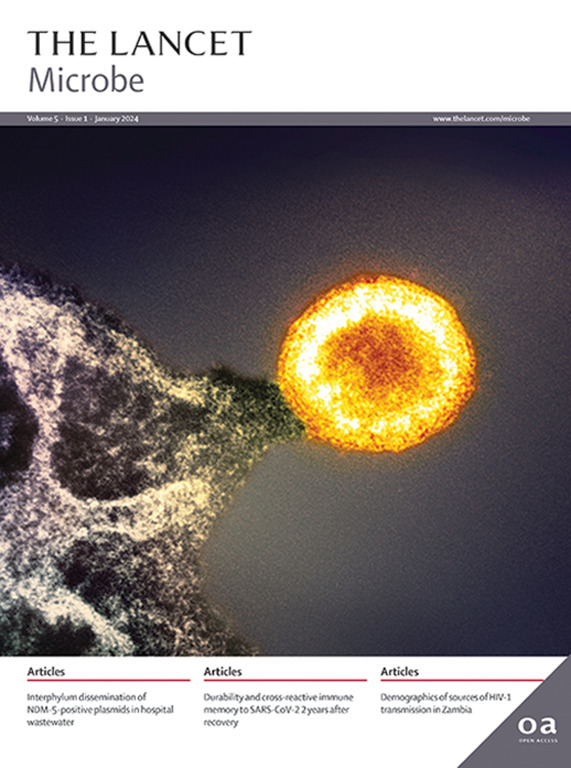Interactions between live attenuated influenza vaccine and nasopharyngeal microbiota among children aged 24–59 months in The Gambia: a phase 4, open-label, randomised controlled trial
IF 20.9
1区 生物学
Q1 INFECTIOUS DISEASES
引用次数: 0
Abstract
Background
Live attenuated influenza vaccines (LAIVs) alter nasopharyngeal microbiota in adults. It is poorly understood why LAIV immunogenicity varies across populations, but it could be linked to the microbiome. We aimed to investigate the interactions between intranasal immunisation with LAIV and nasopharyngeal microbiota composition in children from The Gambia.
Methods
We conducted a phase 4, open-label, randomised controlled trial in Sukuta, The Gambia. Children aged 24−59 months with no underlying illness or history of respiratory illness for at least 14 days before recruitment were eligible. Participants were randomly assigned (2:1) by use of a computer-generated sequence in permuted blocks of 15, stratified by sex, to receive trivalent LAIV either on day 0 (intervention group) or after active follow-up at day 21 (control group). The investigator team was initially masked to block size and randomisation sequence; however, group allocation was later revealed to the team. Microbiome profiles were characterised from nasopharyngeal samples collected from all participants on days 0, 7, and 21 by use of 16S rRNA sequencing. The primary outcomes were the effect of LAIV on nasopharyngeal microbiome profiles on day 7 and day 21, and the association between the nasopharyngeal microbiome at baseline and LAIV-induced mucosal IgA responses at day 21, assessed with permutational ANOVA tests. Asymptomatic respiratory viral co-infection at baseline and year of recruitment (2017 or 2018) were included as covariates. This trial is registered with ClinicalTrials.gov (NCT02972957) and is closed.
Findings
Between Feb 8 and April 12, 2017, and Jan 15 and March 28, 2018, 343 children were screened for eligibility, of whom 220 (64%) children were randomly assigned to the intervention group and 110 (32%) to the control group. 213 (97%) children in the intervention group and 108 (98%) in the control group completed the study and were included in the final analysis. Although we did not observe an independent effect of LAIV on microbial community composition at days 7 or 21, we found that LAIV had an effect dependent on the year of recruitment. LAIV affected microbial community composition in 2018 (R2 1·97% [95% CI 0·85–5·94]; p=0·037), but not in 2017 (1·23% [0·49–4·46]; p=0·091). We also found that viral co-infection at baseline had an effect on microbial composition at day 7, regardless of recruitment year (R2 1·01% [95% CI 0·28–3·01]; p=0·026). Nasopharyngeal microbial community composition at baseline had no effect on mucosal IgA responses to LAIV administration (R2 0·51% [95% CI 0·23–2·49]; p=0·46).
Interpretation
Our findings suggest that the effect of LAIVs on nasopharyngeal microbiota composition in children is modest and temporary; therefore, LAIVs could be used as an intervention to curb influenza in children from low-income and middle-income countries, without causing long-lasting perturbations in nasopharyngeal microbiota. However, nasopharyngeal microbiota at the time of vaccination might not explain the variability observed between individuals in LAIV-induced IgA responses.
Funding
The Wellcome Trust, UK National Institute for Health Research, and Chief Scientist Office Scotland.
冈比亚24-59月龄儿童减毒流感活疫苗与鼻咽微生物群的相互作用:一项4期、开放标签、随机对照试验
背景:减毒流感活疫苗(LAIVs)改变成人鼻咽微生物群。为什么LAIV的免疫原性在不同人群中有所不同,人们知之甚少,但它可能与微生物组有关。我们的目的是调查冈比亚儿童鼻内接种LAIV与鼻咽微生物群组成之间的相互作用。方法:我们在冈比亚苏库塔进行了一项4期、开放标签、随机对照试验。年龄为24-59个月,招募前至少14天无基础疾病或呼吸道疾病史的儿童符合条件。使用计算机生成的顺序随机分配15名参与者(2:1),按性别分层,在第0天(干预组)或在第21天(对照组)积极随访后接受三价LAIV。研究小组最初根据分组大小和随机顺序进行分组;然而,小组分配后来被透露给了团队。使用16S rRNA测序,从所有参与者在第0、7和21天收集的鼻咽样本中鉴定微生物组谱。主要结果是第7天和第21天LAIV对鼻咽微生物组谱的影响,以及第21天基线时鼻咽微生物组与LAIV诱导的粘膜IgA反应之间的关系,通过置换方差分析进行评估。基线和招募年份(2017年或2018年)的无症状呼吸道病毒合并感染被纳入协变量。该试验已在ClinicalTrials.gov注册(NCT02972957),并已结束。结果:在2017年2月8日至4月12日,以及2018年1月15日至3月28日期间,筛选了343名儿童的资格,其中220名(64%)儿童被随机分配到干预组,110名(32%)儿童被分配到对照组。干预组213名(97%)儿童和对照组108名(98%)儿童完成研究并纳入最终分析。虽然我们没有观察到LAIV在第7天或第21天对微生物群落组成的独立影响,但我们发现LAIV的影响与招募年份有关。2018年LAIV影响微生物群落组成(R2 1.97% [95% CI 0.85 - 5.94];P =0·037),2017年P = 1·23%[0·49-4·46];p = 0·091)。我们还发现,无论招募年份如何,基线时的病毒合并感染对第7天的微生物组成都有影响(R2 1.01% [95% CI 0.28 - 3.01];p = 0·026)。鼻咽部微生物群落组成基线对LAIV给药后粘膜IgA反应无影响(R2 0.51% [95% CI 0.23 -2·49];p = 0·46)。解释:我们的研究结果表明,LAIVs对儿童鼻咽微生物群组成的影响是适度和暂时的;因此,laiv可作为一种干预措施,用于抑制低收入和中等收入国家儿童的流感,而不会对鼻咽微生物群造成长期扰动。然而,接种疫苗时的鼻咽微生物群可能无法解释laiv诱导的IgA反应在个体之间观察到的差异。资助:威康信托基金、英国国家健康研究所和苏格兰首席科学家办公室。
本文章由计算机程序翻译,如有差异,请以英文原文为准。
求助全文
约1分钟内获得全文
求助全文
来源期刊

Lancet Microbe
Multiple-
CiteScore
27.20
自引率
0.80%
发文量
278
审稿时长
6 weeks
期刊介绍:
The Lancet Microbe is a gold open access journal committed to publishing content relevant to clinical microbiologists worldwide, with a focus on studies that advance clinical understanding, challenge the status quo, and advocate change in health policy.
 求助内容:
求助内容: 应助结果提醒方式:
应助结果提醒方式:


